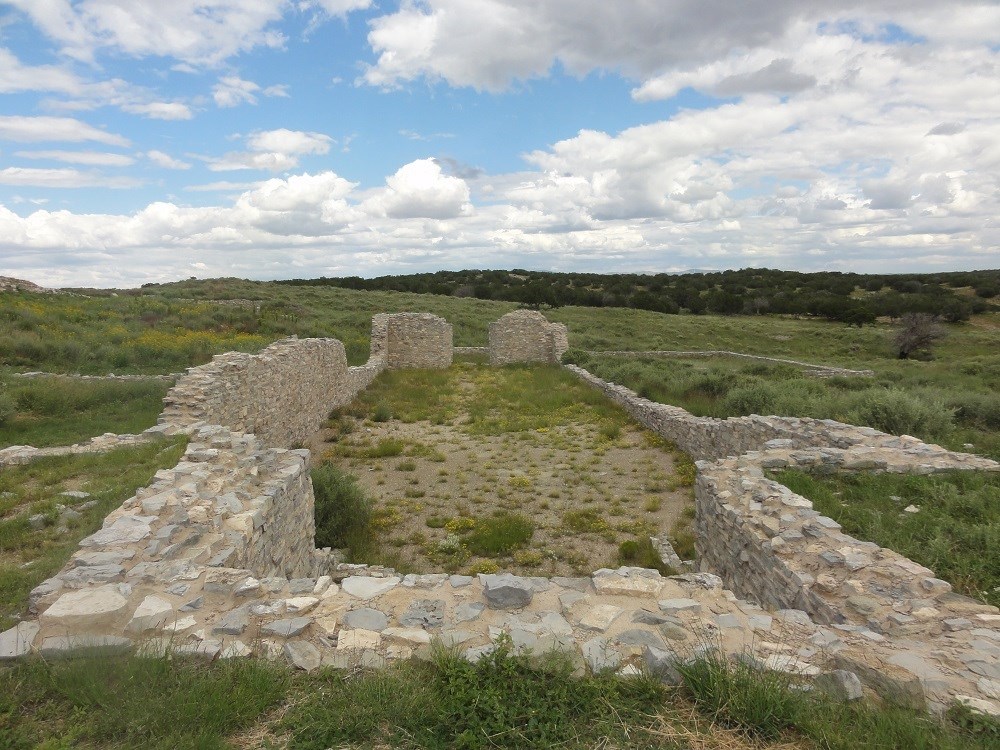Last updated: March 6, 2023
Article
Gran Quivira and the Antiquities Act

Gran Quivira's site history began ca. 800 with a sedentary native population dwelling in pithouses. Archaeological evidence indicates that by 1300 the rise overlooking the southern Estancia Basin was inhabited by Tompiro-speaking peoples who built the culturally distinct pueblo masonry architecture, called Las Humanas by the Spaniards, that so fascinates us today. Living in a land with scarce water, these early peoples subsisted from hunting, gathering, and agricultural activities, allowing them to develop trade relationships with the Apaches and other tribes. It was into this delicate balance of subsistence that the Spanish entered.
In 1598, while exploring the territory he had claimed for Spain, Don Juan de Oñate arrived at Las Humanas and administered an oath of obedience and vassalage to the Humano Indians, precipitating a tumultuous relationship between the natives and the Spanish conquerors that would last for nearly one hundred years. He also left behind the indelible marks of a collision between cultures. The later shift in colonial interests from mineral wealth to the conversion of the native inhabitants resulted in lasting effects in the role of the church versus the role of the civil authorities that pinned the Indians between the competing Spanish factions and their plans for the land and its people.
Missionary activities at Las Humanas began in earnest and around 1626 the pueblo was designated as a visita of San Grégorio de Abó mission. By 1629 Las Humanas had its own resident priest, Fray Francisco de Letrado, who in 1631 began construction on a new church and convento. Although Letrado was transferred before the new church was finished, his successor, Fray Francisco de Acevedo, supervised the completion of a small church that was dedicated to San Isidro in 1629. As Las Humanas fought to gain full mission status, a second and larger church was begun by Fray Diego de Santandér upon his arrival at Las Humanas after 1659.
Trouble soon followed, as tensions that had long been mounting between the civil and ecclesiastical authorities were exacerbated by the fight over who among the Spanish had the right to direct the labor of the Indians. Governors sought native labor to increase their personal wealth while undermining the authority of the priests among the Indians. Secular authorities captured Apaches for use as slave labor or for sale to the northern areas of New Spain, causing retaliatory attacks by the Apaches upon spiritual centers which were located in outlying areas like Las Humanas. By 1660 amidst this turmoil, Humano inhabitants found themselves in the grip of drought and famine without government aid, surviving only on food brought into the Salinas Basin from other missions. Persistant drought plagued the area, eventually leading to the starvation deaths in 1668 of over 450 Humano Indians. A mass grave of more than 450 individuals in the cemetery at Gran Quivira illustrates the ravages of disease and famine on the native population during the late 17th century. In September 1670, Apaches raided Las Humanas and destroyed the mission and pueblo leaving eleven dead and taking thirty inhabitants as captives. By 1672 the site was abandoned.
The pueblo remained vacant for over a hundred years until a new wavw of explorers rediscovered the imposing ruins of the mission and pueblo mounds. In 1773-74 John Rowzée Peyton, a Virginian traveling up the Rio Grande valley, found his way to the east side of the mountains and left one of the first descriptions of Gran Quivira after its abandonment. Later travelers, such as James W. Abert in 1846 and Major James Henry Carleton in 1853, would also visit the site and leave descriptions and views of the ruins complex. In 1883 archeological studies began with Adolph Bandelier who described, photographed, and mapped the ruins.
President Taft established Gran Quivira National Monument on November 1, 1909 to preserve “one of the largest and most important of the early Spanish church ruins” as well as "numerous Indian pueblo ruins in its vicinity" (Proc. No. 882). Today, Gran Quivira is part of the Salinas Pueblo Missions National Monument, which includes 1071 acres. Almost 50,000 visitors come each year to walk through the ruins of Gran Quivira via an interpretive trail. A series of archeological excavations and stabilization efforts have cleared away fallen debris to reveal the walls of the Spanish church of San Buenaventura, the unfinished church, the convento as well as the mounded ruins of the Indian village.
